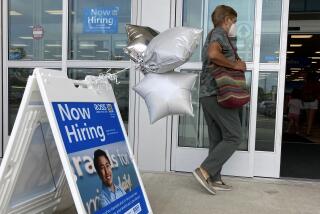Jobless Rate Reaches 5.8%; Snow a Factor
WASHINGTON — The January blizzard that closed stores, shops and factories on the East Coast helped push the unemployment rate to 5.8% last month, the highest level since last spring, the Labor Department reported Friday.
Payrolls plunged by 201,000 jobs, but the storm made it impossible to determine whether the economy suffered a significant slowdown or was simply a victim of nature, officials said.
The jobless rate has been moving in a narrow range, between 5.4% and 5.8%, since September 1994. Business is creating barely enough jobs to provide work for a slowly growing labor force.
The snow and ice of January caused a “temporary economic skid,” Labor Secretary Robert B. Reich said. But “we are not spinning our wheels, and there is no reason to suppose we are in a stall.”
The rate was 5.6% in December. Declines were seen across the board in manufacturing, retail trade and even the normally robust temporary help business. A 5.8% jobless rate was last reached in April 1995. And payrolls had not fallen by as much as 200,000 since April 1991, when the economy was in recession.
However, experts urged caution in discussing the January payroll plunge.
“It is difficult to know what to make of it,” Katherine G. Abraham, commissioner of labor statistics, said at a hearing of Congress’ Joint Economic Committee. “The blizzard just really confounds things and makes it hard to interpret the data.”
The storm affected 30% of the jobs in the U.S. in some way. Businesses were closed or open for shorter periods; some employees could not get to work or came late.
In a typical January, about 1 million people work irregular hours because of bad weather. Last month, the total soared to 10 million.
Manufacturing employment fell by 72,000 last month, with declines in textiles, apparel and automobiles. High inventories of cars and trucks forced temporary shutdowns of 13 auto assembly plants and the layoffs of 22,000 workers.
Retail trade jobs dropped by 41,000 as the weather hurt business for restaurants and stores.
Construction employment gained 13,000 jobs, helped by a strong revival of building activity in California. Many of the construction jobs lost in the East because of the storm were offset by hirings for snow removal.
There were 125.2 million Americans working last month and 7.7 million unemployed.
Even discounting the impact of snow and ice, the economy has been sluggish since last spring. Job growth averaged 119,000 a month from March through December, a weak performance compared with the payroll expansion of 294,000 jobs a month in 1994.
“We’re certainly not looking at a robust economy at the moment, but we’re also not looking at any fundamental reason why this economy should turn sour,” said Barry Rogstad, president of the American Business Conference, a group of high-growth companies.
“I don’t see any real pattern,” he said. “Some members say things are great, going gangbusters, and others are very worried about softness in sales.”
Sharing fears about a potential recession, the Federal Reserve Board moved Wednesday to lower interest rates, making homes and cars more affordable and easing the cost of borrowing for business.
“The Fed should have acted sooner, and they still have to do more,” said Jerry Jasinowski, president of the National Assn. of Manufacturers, who viewed Friday’s jobless report as “quite disturbing.”
“The economy is suffering from a lot more than the winter snowstorms. The consumer is tapped out and the inventory overhang is a big problem,” Jasinowski said.
“There are no signs of growth that will give the economy a positive first quarter,” he said.
In financial markets Friday, however, one aspect of the January employment report was troubling: Despite the falloff in jobs, hourly wages jumped 0.5%. That signaled to some investors that wage inflation may be accelerating.
However, many economists said the increase was a fluke. More lower-wage workers probably couldn’t get to work because of weather and weren’t paid, so higher-wage earners skewed the earnings figure, they said.
Friday’s employment report was restricted to the overall U.S. jobless rate. California and 10 other large states no longer have their results reported with the national figure. The sample for the survey was reduced from 56,000 to 50,000 households, making the estimates less statistically reliable.
California and the other populous states will now be included in the model used for reporting 39 states and the District of Columbia. The report will be issued later this month.
More to Read
Inside the business of entertainment
The Wide Shot brings you news, analysis and insights on everything from streaming wars to production — and what it all means for the future.
You may occasionally receive promotional content from the Los Angeles Times.










